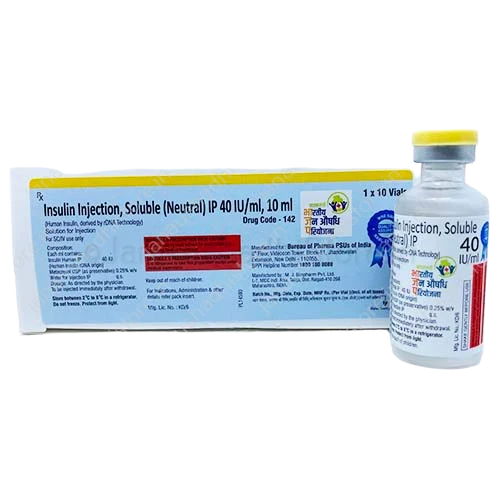
142 Soluble Insulin Injection IP 40 IU per ml (R-DNA Origin)
Rapid Acting Insulin Solution
₹71.01
Soluble Insulin Injection IP 40 IU per ml (R-DNA Origin) delivers reliable glycemic control for individuals with diabetes mellitus. This high-quality, R-DNA origin insulin offers rapid absorption and is suitable for both type 1 and type 2 diabetes management.
Soluble Insulin Injection IP 40 IU/ml is a short-acting recombinant DNA (r-DNA) human insulin used for controlling blood sugar levels in patients with type 1 and type 2 diabetes mellitus.
What is Soluble Insulin Injection?
It is a fast-acting, clear, colorless insulin solution prepared by recombinant DNA technology to mimic human insulin. This insulin facilitates glucose uptake into muscle and fat cells, suppresses glucose production in the liver, and thereby lowers blood sugar levels after meals. It can be administered subcutaneously, intravenously (in hospital settings), or intramuscularly under medical supervision. It is commonly prescribed alongside diet, exercise, and sometimes other insulin or oral antidiabetic medications for better diabetes control.
Uses and Benefits
Soluble Insulin Injection is used to:
Manage blood glucose in type 1 diabetes (insulin-dependent) and some cases of type 2 diabetes.
Prevent or delay diabetic complications such as kidney damage, eye damage, nerve problems, and limb loss.
Stabilize blood sugar during emergencies like diabetic ketoacidosis and hyperosmolar hyperglycemic states.
Be applied in combination with intermediate- or long-acting insulins or oral agents as per doctor’s advice.
Improve overall glycemic control, supporting a healthy metabolism.
How to Use and Dosage
Inject subcutaneously into the abdomen (preferred for faster absorption), thigh, upper arm, or buttocks. Rotate injection sites to avoid skin problems.
Usually taken 20 to 30 minutes before meals to match mealtime glucose rise.
Dosage is individualized based on patient needs, blood sugar monitoring, diet, exercise, and insulin sensitivity.
In hospitals, it can be given intravenously under strict monitoring for rapid effect.
When mixing with other insulin types (e.g., NPH), draw soluble insulin first, then the other insulin, and inject immediately.
Onset and Duration
Starts acting within 30 minutes to 1 hour after subcutaneous injection.
Peak activity between 1.5 to 3.5 hours.
Duration of action lasts approximately 6 to 8 hours.
Faster onset when given intravenously with a shorter half-life in the bloodstream.
Side Effects
Most common: hypoglycemia (low blood sugar), which can cause sweating, shakiness, headache, hunger, dizziness, and in severe cases, unconsciousness.
Injection site reactions: redness, swelling, itching, or lipodystrophy (skin tissue changes) with repeated use at the same site.
Possible weight gain and peripheral edema due to fluid retention.
Allergic reactions are rare but may include rash, breathing difficulty, or anaphylaxis.
Alcohol intake can increase hypoglycemia risk; maintain regular meals and monitor blood glucose closely.
Special Precautions and Warnings
Do not use during episodes of hypoglycemia.
Adjust doses carefully if liver or kidney impairment is present, during illness, or with changes in physical activity or diet.
Consult a doctor during pregnancy or breastfeeding; dosage adjustment may be necessary.
Use a proper syringe for 40 IU/ml insulin (U-40 insulin syringe) to avoid dosing errors.
Avoid reusing needles or syringes to prevent infections.
Monitor blood potassium levels with intravenous use, as insulin can cause hypokalemia.
Storage
Store unopened vials refrigerated at 2–8°C.
Do not freeze.
Opened vials can be kept at room temperature (below 25-30°C) and should be used within 4 weeks.
Protect from light and heat.
Always check for clarity; do not use if discolored or cloudy.
Summary
Soluble Insulin Injection IP 40 IU/ml (R-DNA origin) is a fast-acting human insulin used primarily to control blood sugar in diabetes, especially around mealtime. It is administered via injection under medical supervision with careful dose adjustment individualized to the patient’s needs. Regular glucose monitoring is crucial to prevent hypoglycemia. The treatment is part of an overall diabetes management plan including diet, exercise, and other medications if prescribed. Proper storage and administration ensure its effectiveness and safety.
© 2025. All rights reserved by Ross & Fleming India Super-specialty Clinics